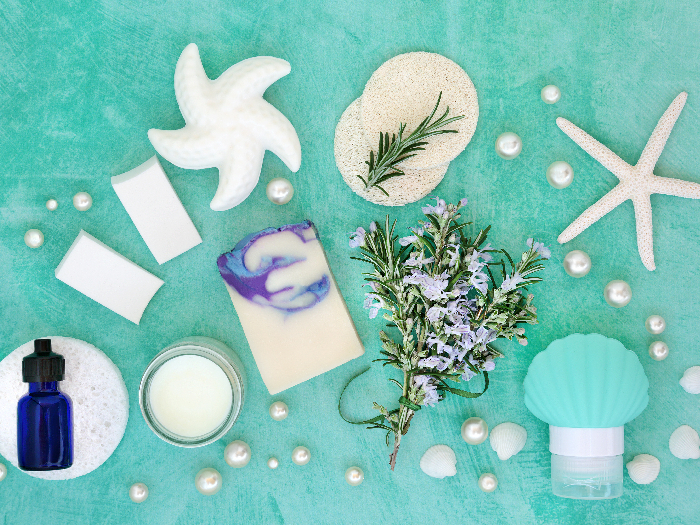An astringent can be used in a variety of medical and cosmetic contexts and can either be artificial or natural in origin.
What is Astringent?
An astringent, by scientific definition, is a chemical that shrinks or constricts the tissues of the body. These compounds are found in several plants, flowers, and fruits, but other substances display characteristics of astringency. In medical applications, an astringent can be applied to reduce the emission of bodily fluids from tissues, such as blood or mucus. These types of medications or topical treatments can be used for sore throats, cold sores, hemorrhoids, and small wounds, as well as pimples, blackheads, and acne. [1]
These last few conditions segue nicely into the cosmetic meaning of “astringent”, a common product that people apply to their face to reduce oil on their skin. Such astringents come in many forms, and are often alcohol-based, though you can find alcohol-free and purely organic varieties too. Astringents are water-based cleansers that can have a variety of benefits for your skin, as will be explained below, but they aren’t always the best choice for your skincare regimen. Let’s take a detailed look at it.
Benefits
People use astringent substances for many reasons, but the primary benefits include reducing acne, tightening the skin, shrinking/unclogging pores, reducing oil production, and cleansing the skin.

Astringents may help cleanse the skin, tighten pores, and dry out oil. Photo Credit: Shutterstock
- Tighten the Skin: One of the most widespread reasons for using an astringent is tightening the skin. This can help with the clenching of tissues and reduce the appearance of wrinkles and increase youthfulness. Regular application of astringent can also slow the skin-aging process. [2]
- Shrink/Unclog Pores: When the astringent substance causes pores to shrink, it also prevents these pores from being clogged. This makes it easier to wipe away or remove excess irritants and oil from the skin. The use of such compounds will also reduce the appearance of pores on your skin, providing a smoother appearance. [3]
- Oily Skin: A primary function of an astringent compound is to remove oil from the skin. If you feel that your face has a constant shine, and you’re prone to pimples on your face, removing this excess oil is one of the major benefits of using this cosmeceutical substance. [4]
- Acne: An astringent is particularly effective if you are prone to acne, which can cause extreme inflammation of your pores and is often characterized by oily skin. A substance that shrinks the pores, eliminates oil, and reduces inflammation is precisely what you want in the case of a severe acne breakout, or a chronic problem with this skin condition. [5]
- Overall Cleansing: Many astringent products will also have antibacterial additives or salicylic acid, which will keep your skin free of potential bacterial infections. This is particularly true in the case of herbal or all-natural astringents, which may have many anti-inflammatory, antifungal, and therapeutic effects. [6]
Astringent vs Toner
Many people think of astringent and toner as the same thing. While they are both water-based cleansers, often used on the face, there are some key differences, particularly if you have a sensitive skin type.
A toner is akin to a mild astringent, as it can cleanse the face of residue, and provide an even tone to the skin, but it can’t remove oil. For this reason, toner is typically recommended for people with dry or sensitive skin, as they don’t have an excess amount of oil to remove. [7]
Both astringent and toner are applied in the same way—after face wash and before moisturizing, applied with a cotton ball. However, only the latter temporarily tightens the skin and provides a refreshing feeling to the skin. Toner can be applied widely, without much fear of side effects, provided the ingredients are of high quality. It is recommended that astringent be used in moderation.
Astringent Use Based on Skin Types
As mentioned above, astringent is primarily useful for those with oily skin who are prone to acne. The oil-eliminating aspect of an astringent is what sets it apart from toner and other cosmetic compounds.
- Dry Skin: If you already have dry skin and use an alcohol-based astringent, you are likely to exacerbate the dryness, resulting in redness and irritation.
- Normal to Dry Skin: If you have normal to dry skin, you will want to choose a milder cleanser, such as a toner.
Word of Caution
Due to the powerful nature of astringent substances, it is not appropriate for everyone or every skin type. Many astringents, particularly less expensive varieties, will contain high levels of alcohol, which can severely dry out the skin. Therefore, if you have dry skin or a condition like rosacea or eczema, do not use alcohol-based astringents. Many options have low alcohol content or are completely natural, using only organic sources of astringent chemicals.
On a lesser note, some people don’t enjoy the sensation of tightly pulled skin, nor do they enjoy the occasional irritation or redness that these compounds can cause.
